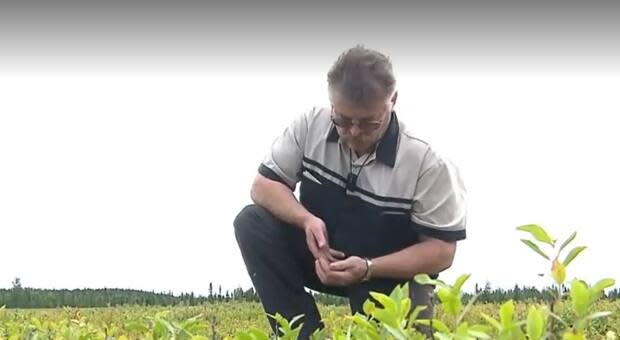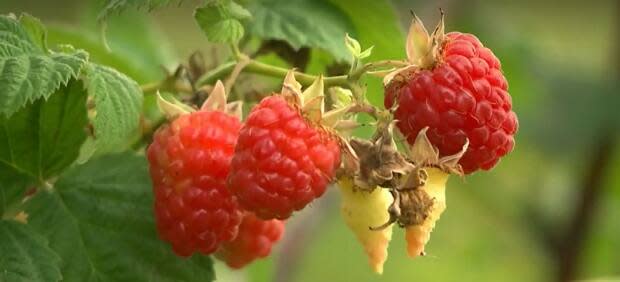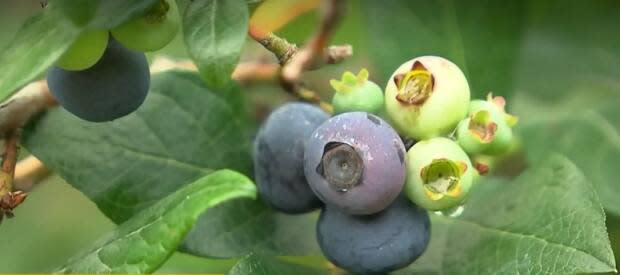Ottawa wants to allow more pesticide residue in wild blueberries

Health Canada is proposing to allow three times the current limit for residue of an insecticide and a fungicide in wild blueberries sold to Canadian consumers.
It's also proposing a seven-fold increase for a fungicide in raspberries.
Two public consultations are underway, one of which ended Tuesday. The other is ongoing until September 28.
Federal officials say there is no health risk.
Lac-Saint-Jean, Que., blueberry farmer and president of the Quebec association of blueberry producers Daniel Gobeil said he was astonished to hear about the proposals.
Producers never asked Health Canada for the increases, he said.

"On the contrary," said Gobeil, in a French-language interview with Radio-Canada. "Our members are increasingly going organic."
Donald Arseneault, executive director of NB Blueberries, said New Brunswick producers did not make the request either.
Arsenault also said most New Brunswick producers sell their berries to Oxford Frozen Foods, which provides producers with a list of acceptable pesticides and herbicides. He said neither of these chemicals are on that list.
Documents on the Health Canada website indicate the federal Pest Management Regulatory Agency has proposed increasing the residue limit for the fungicide metalaxyl in blueberries from three parts per million to 10 parts per million.
For the insecticide sulfoxaflor, it has proposed increasing the limit from 0.7 ppm to 2 ppm.
For raspberries, the metalaxyl limit would increase from 0.2 ppm to 1.5 ppm.

The president of the Quebec Association of Strawberry and Raspberry Producers, David Lemire, was also unaware of the proposed change.
"This is really not a request from Quebec," he said.
"To me, this is incomprehensible."
"We have no interest in increasing that limit," said Lemire, "because it could allow products that don't meet the current standards to enter the local market."

During a recent consultation on glyphosate, changes were said to be necessary because of import and sales requirements.
But documents for the current consultations do not specify a reason for these proposed changes.
The documents don't name the applicants, either.
In the case of glyphosate, the applicant was Bayer, the manufacturer of the herbicide Roundup.
Health Canada did not answer Radio-Canada's questions about the current applicants.
But a group representing pesticide manufacturers, CropLife, recently acknowledged product registrants ask for reviews of residue limits on a regular basis.

The American company which markets sulfoxaflor, Corteva Agriscience, said it did not request the increase for blueberries now being considered.
"It's a bizarre situation," said Louise Vandelac, a professor and pesticide specialist at Université du Québec à Montréal's Institute of Environmental Sciences.
"There's a complete lack of transparency," she said.
"It's a vicious circle," said Vandelac, "when industry data is used to evaluate industry requests."

The applicant provided data that doesn't specify how or where field tests were done.
It said the highest average metalaxyl residue found in raspberries was 0.686 ppm.
Ottawa is proposing a limit that's more than twice that rate.
Health Canada's document says the "risks" of that are "acceptable to human health and the environment."
Metalaxyl is a fungicide that helps control root rot. It is marketed under the Orondis-Gold brand by the Swiss multinational Syngenta.

It is a systemic pesticide, which is absorbed by the leaves, stems and roots.
"The product circulates inside a plant," explained Louise Hénault-Ethier, research associate at Quebec's National Institute for Scientific Research and director of the Water Earth Environment Research Centre.
"The flesh of the whole fruit may possibly contain the pesticide, if we are talking about a systemic product," she said.
Sulfoxaflor is an insecticide that helps control aphids and bedbugs. It is marketed under the Closer brand by the American multinational Corteva.

According to the Quebec pesticide database, sulfoxaflor is "toxic to bees." In addition, "neurodevelopmental effects" were observed in laboratory rats. It's not known whether those effects would also apply to humans.
Canadians consume an average of 1.1 kg of blueberries per year and 1.43 kg through processed products, according to Statistics Canada.
In its assessment, the Pest Management Regulatory Agency takes into account the average food consumption, but Henault-Éthier and Vandelac question this approach.
They are worried about the diet of certain Indigenous populations and residents of Lac-Saint-Jean, who eat more wild blueberries.

